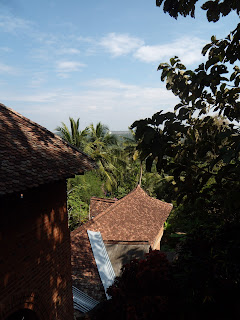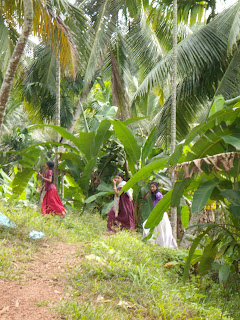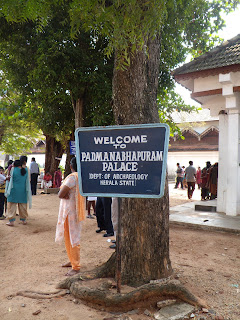 An interesting day to say the least, filled with tours. However one was special. We were given the chance to tour Laurie Baker's home. While touring, we were surprised to see his wife, Mrs. Baker of 94 years sitting upright on her bed. Her age surprised me, especially in a developing country. It was quite an honor as she practiced medicine and opened clinics in the slums to serve the underpriveleged population. If nothing else, we have met both outstanding scholars and genuine people who care about humanity.
An interesting day to say the least, filled with tours. However one was special. We were given the chance to tour Laurie Baker's home. While touring, we were surprised to see his wife, Mrs. Baker of 94 years sitting upright on her bed. Her age surprised me, especially in a developing country. It was quite an honor as she practiced medicine and opened clinics in the slums to serve the underpriveleged population. If nothing else, we have met both outstanding scholars and genuine people who care about humanity.It was unique to walk through his house and learn the reasoning behind his designs. I should note, prior to attending his home and Merle Kindred's home, tradition is for the family to sleep in one room, and to succeed as the elsest move out. Therefore Laurie Baker and his children all shared one room. Touring the rest of the home, we were taken to the fourth floor, the top, and saw an amazing view of Kerala. His home has been turned into COSTFORD offices and provides a studio for architects.
 Artwork from stone imprinted in the wall.
Artwork from stone imprinted in the wall.The tour of Laurie Baker's home was followed by a tour of Merle Kindred's home. She had a COSTFORD home built as well. Merle is a scholar looking at energy issues solved by technology and communication. She is now living six months in India, the other six in Canada, doing research and advocating for COSTFORD. She presented a powerpoint on COSTFORD housing matching Ghandian ideals, particularly their utilization of natural resources. She included in her powerpoint a quote from Ghandi that really stood out to me "The Earth is for every man's need, not every man's greed." and I believe COSTFORD models support that. Ghandi believed building materials should come from a 5 mile radius, which COSTFORD also models by using local resources. Ghandian ideals are incorporated by COSTFORD as they do not misuse natural resourcse which Ghandi considered violence against nature, and do not overconsume, which Ghandi considered violence against humanity. Lastly, many COSTFORD structures contain benches which Ghandi (and Laurie Baker) deemed vital for successful personal relationships and social interactions.
Below you can see pictures from the Aryand Panchayat. A Panchayat is similiar to a district in the States; a governing body for localities, and in India, the village. However, it is run by the people, and provide services area specific, such as schools, diabetes clinics, co-operatives.
 These pictures illustrates a co-operative running inside the village of Aryand, which cultivates and sells rice and bananas. The co-operative consists of five women and their families who rent this land. The woman below responded to the call from the village Panchayat Bank to rent the land for two years becuase she knew agriculture. These women are able to provide a supplemental income to their households and pass the trade of agriculture and food security to future generations. Although they cannot own the land, they are encouraging women to partake in the local economy and demonstrating women can have control.
These pictures illustrates a co-operative running inside the village of Aryand, which cultivates and sells rice and bananas. The co-operative consists of five women and their families who rent this land. The woman below responded to the call from the village Panchayat Bank to rent the land for two years becuase she knew agriculture. These women are able to provide a supplemental income to their households and pass the trade of agriculture and food security to future generations. Although they cannot own the land, they are encouraging women to partake in the local economy and demonstrating women can have control.






























 These two illustrate a bench for kneeling and small windows in the wall used for women to watch events in the dance hall as they were not allowed to be seen by the public. To the right, you can see the dance hall.
These two illustrate a bench for kneeling and small windows in the wall used for women to watch events in the dance hall as they were not allowed to be seen by the public. To the right, you can see the dance hall.





















